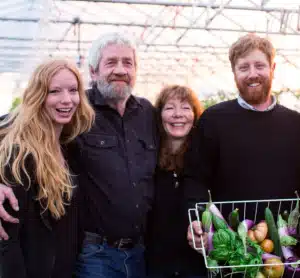

When visiting Amaltheia Organic Dairy on a sunny September day, the efficient energy of the farm is palpable– two employees bustle away at the onion processing machine in a greenhouse, while goats bleat before their evening milking. Meanwhile, a hundred feet away, a fleet of piglets trail behind their mother while other pigs munch on green cabbage from the vegetable field. The proximity of many different kinds of life –greenhouses, livestock, vegetable fields and humans– is a testament to Amaltheia’s careful thinking in how to integrate many different operations into one efficient closed loop.

Amaltheia was founded by Sue and Mel Brown in 2000 as a dairy goat farm, and has since grown into a diverse business that sells a wide variety of vegetables and pork meat, in addition to its renowned goat cheeses. Now, Sarah and Nate, the Brown’s daughter and son, help steward the farm alongside their parents. Sarah works as head cheese maker on the dairy side, and Nate leads livestock operations and the vegetable expansion. Since its founding, the Browns have prioritized the effort to be completely sustainable, aiming to be a zero-emissions operation.
As I learn from Nate, soil, livestock, vegetables and human health are all a part of the equation.

It’s not often that you look at a pile of goat manure and call it “elegant,” but that is exactly how I would describe Amaltheia’s compost pile. The manure is piled cleanly and turned for composting within the goat pen, removing one step in the transportation of the nutrient-rich material. Nate describes: “Twice a year, we take out the goats’ old straw and hay, and then their manure, and then we pile it all up within the pen, and then turn it once a week.”
In order to compost it to organic standards, Nate spreads the compost mixture in the vegetable fields with the cover crop each season. The three-acre vegetable fields are an expansion on Amaltheia’s leased property where they grow onions, kale, beets, carrots, radishes, and much more.
Nate explains, “When we expanded the amount of lease land, we started using composted manure on our own vegetables. We’re trying to do more year-round cover cropping, but we also integrate the livestock into treating the land.”

Amaltheia invites 13 Mile Lamb, a nearby lamb and wool producer, to graze their sheep on Amaltheia’s cover crop. Nate says: “They do a great job on the thistle.”
Meanwhile, the feed mix for the pigs comes out of Clearlake Organic Farm in Fort Benton, Montana, owned by Casey Bailey. Clearlake Farm grows peas, barley, and flax altogether and combines it to add diversity to his own grain rotation and soils, while simultaneously adding diversity to the nutrition of the pigs. Amaltheia grinds the grains themselves with a mineral mix and salt.
“It’s important to realize there’s a lot of good farming practices that go into our end product,” Nate says, “and a lot of families that are supported throughout the process.”

Indeed, between organic livestock feed producers in Fort Benton, to lamb producers in the Gallatin Valley, to local farmers markets and restaurants, Amaltheia is a confluence of many different players in local Montana food. While Amaltheia’s operations may be significantly smaller than an industrial vegetable or livestock farm, they are formidable in the diversity and efficiency they achieve.
As Nate and I stop to talk in the goat pen, a very tiny white goat with long horns approaches us. Nate says: “He’s very friendly. He was a little runt goat that we couldn’t help but keep. We call him ‘Itty Bitty.’” He continues, “When Itty Bitty was born, he would fit in the palm of your hand. We nursed him back to health.”
Nate gives Itty Bitty’s head a scratch. Despite the goat’s small stature, he’s got a little magic to him.
“He’s kind of our farm mascot.”
There’s something fitting in that.
Find Amaltheia Organic Dairy at Abundant Montana!
